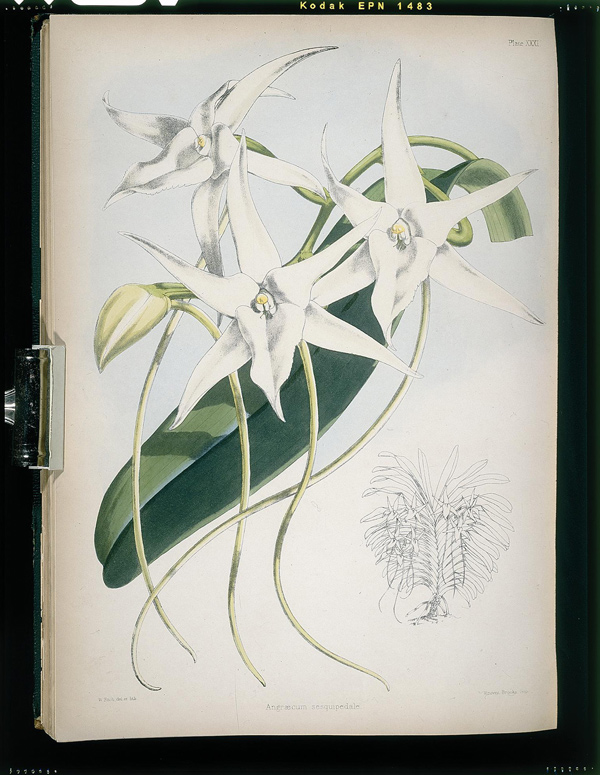The Huntington’s blog takes you behind the scenes for a scholarly view of the collections.
ORCHID COLLECTION | The Star of Bethlehem Discovered!
Posted on Fri., Dec. 21, 2012 by

Orchid (Angraecum sesquipedale), from Robert Warner’s Select Orchidaceous Plants (1865–67). This print was on view at The Huntington in the fall of 2008 for the exhibition “Darwin’s Garden: An Evolutionary Adventure.” Courtesy of LuEsther T. Mertz Library, the New York Botanical Garden.
Astronomers throughout history have searched the skies in hopes of locating the Star of Bethlehem, the famed star of scripture. Meanwhile botanists have found their very own “Star of Bethlehem” among the Orchid family.
Angraecum sesquipedale, also known as the Star of Bethlehem to orchid collectors, was first discovered by Louis-Marie Aubert du Petit-Thouars in Madagascar around 1798. Notable for its large and white star-like flowers, it has long been nicknamed the Star of Bethlehem. The flowers are very thick with a waxy-like texture to the surface. It also has a spur that can get as long as 12 inches. (The spur is a very long tube that houses all the nectar a flower produces.)
During the early 1800s, Petit-Thouars returned to France with the Angraecum; it wasn’t officially described until 1822. In the 1860s, Charles Darwin came across the species in bloom and theorized that its pollinator must be a yet-to-be-discovered insect with a very long proboscis. In 1862 he published the book Fertilisation of Orchids, where he explained his many theories on the pollination of orchids, including Angraecum sesquipedale.
It wasn’t until 1903, 21 years after Darwin’s death, that his theory was proven to be correct. The moth Xanthopan morganii was discovered in Madagascar, near the same region where Angraecum sesquipedale was discovered. The moth indeed had a long proboscis, a long mouth-like appendage that is used to suck and feed after uncurling and inserting it into the spur of the flower. Its proboscis ranges from 9 to 13 inches long.
The Star of Bethlehem is just one of the many orchids that have evolved over time to adapt and accommodate to their environment and pollinators.
Brandon Tam is The Huntington’s orchid specialist.